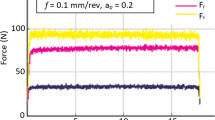Abstract
Support vector machines are arguably one of the most successful methods for data classification, but when using them in regression problems, literature suggests that their performance is no longer state-of-the-art. This paper compares performances of three machine learning methods for the prediction of independent output cutting parameters in a high speed turning process. Observed parameters were the surface roughness (Ra), cutting force \((F_{c})\), and tool lifetime (T). For the modelling, support vector regression (SVR), polynomial (quadratic) regression, and artificial neural network (ANN) were used. In this research, polynomial regression has outperformed SVR and ANN in the case of \(F_{c}\) and Ra prediction, while ANN had the best performance in the case of T, but also the worst performance in the case of \(F_{c}\) and Ra. The study has also shown that in SVR, the polynomial kernel has outperformed linear kernel and RBF kernel. In addition, there was no significant difference in performance between SVR and polynomial regression for prediction of all three output machining parameters.



Similar content being viewed by others
References
Abu-Mostafa, Y. S., Magdon-Ismail, M., & Lin, H. T. (2012). Learning from data. A short course. AMLbook.com.
Aydin, M., Ucar, M., Cengiz, A., Kurt, M., & Bakir, B. (2014). A methodology for cutting force prediction in side milling. Materials and Manufacturing Processes. doi:10.1080/10426914.2014.912315.
Bishop, C. M. (2005). Neural networks for pattern recognition. Oxford: Oxford University Press.
Brezocnik, M., Kovacic, M., & Ficko, M. (2004). Prediction of surface roughness with genetic programming. Journal of Materials Processing Technology. doi:10.1016/j.jmatprotec.2004.09.004.
Campbell, C., & Ying, Y. (2011). Learning with support vector machines. In Synthesis Lectures on Artificial Intelligence and Machine Learning. California: Morgan and Claypool Publishers. doi:10.2200/S00324ED1V01Y201102AIM010.
Cho, S., Asfour, S., Onar, A., & Kaundinya, N. (2005). Tool breakage detection using support vector machine learning in a milling process. International Journal of Machine Tools and Manufacture,. doi:10.1016/j.ijmachtools.2004.08.016.
Cukor, G., & Jurkovic, Z. (2010). Optimization of turning using evolutionary algorithms. Engineering Review, 30, 1–10.
Cukor, G., Jurkovic, Z., & Sekulic, M. (2011). Rotatable central composite design of experiments versus Taguchi method in the optimization of turning. Metalurgija, 50, 17–20.
Hrelja, M., Klancnik, S., Irgolic, T., Paulic, M., Jurkovic, Z., Balic, J., & Brezocnik, M. (2014). Particle swarm optimization approach for modelling a turning process. Advances in Production Engineering & Management. doi:10.14743/apem2014.1.173.
Jurkovic, Z., Cukor, G., & Andrejcak, I. (2010). Improving the surface roughness at longitudinal turning using the different optimization methods. Technical Gazette, 17, 397–402.
Kocyigit, N. (2015). Fault and sensor error diagnostic strategies for a vapour compression refrigeration system by using fuzzy inference systems and artificial neural network. International Journal of Refrigeration. doi:10.1016/j.ijrefrig.2014.10.017.
Krizek, Z., Jurkovic, Z., & Brezocnik, M. (2008). Analytical study of different approaches to determine optimal cutting force. In 12th international research/expert conference on the trends in the development of machinery and associated technology (TMT). Istanbul, Turkey, August 26–30.
Lela, B., Bajic, D., & Jozic, S. (2009). Regression analysis, support vector machines, and Bayesian neural network approaches to modelling surface roughness in face milling. The International Journal of Advanced Manufacturing Technology. doi:10.1007/s00170-008-1678-z.
Mahesh, G., Muthu, S., & Devadasan, S. R. (2015). Prediction of surface roughness of end milling operation using genetic algorithm. The International Journal of Advanced Manufacturing Technology. doi:10.1007/s00170-014-6425-z.
Mgwatu, M. I. (2013). Integrated approach for optimising machining parameters, tool wear and surface quality in multi pass turning operations. Advances in Production Engineering & Management. doi:10.14743/apem2013.4.168.
Saric, T., Simunovic, G., & Simunovic, K. (2013). Use of neural networks in prediction and simulation of steel surface roughness. International Journal of Simulation Modelling. doi:10.2507/IJSIMM12(4)2.241.
Senthilkumar, N., Tamizharasan, T., & Anandakrishnan, V. (2013). An ANN approach for predicting the cutting inserts performances of different geometries in hard turning. Advances in Production Engineering & Management. doi:10.14743/apem2013.4.170.
Sivarao, Brevern, P., & El-Tayeb, N. S. M. (2009a). A new approach of adaptive network-based fuzzy inference system modeling in laser processing-A graphical user interface based. Journal of Computer Science. doi:10.3844/jcssp.2009.704.710.
Sivarao, Brevern, P., El-Tayeb, N. S. M., & Vengkatesh, V. C. (2009b). Neural network multi-layer perceptron modeling for surface quality prediction in laser machining. Application in Machine Learning. doi:10.5772/8612.
Sivarao, Brevern, P., El-Tayeb, N. S. M., & Vengkatesh, V. C. (2009c). Modeling, testing and experimental validation of laser machining micro quality response by artificial neural network. International Journal of Engineering & Technology, 9(9), 161–166.
Sivarao, Brevern, P., El-Tayeb, N. S. M., & Vengkatesh, V. C. (2009d). Modeling of laser processing cut quality by adaptive network-based fuzzy inference system (ANFIS). Journal of Mechanical Engineering Science. doi:10.1243/09544062JMES1319.
Smola, A. J., & Scholkopf, B. (2004). A tutorial on support vector regression. Statistics and Computing. doi:10.1023/B:STCO.0000035301.49549.88.
Tamang, S. K., & Chandrasekaran, M. (2015). Modeling and optimization of parameters for minimizing surface roughness and tool wear in turning Al/SiCp MMC, using conventional and soft computing techniques. Advances in Production Engineering & Management. doi:10.14743/apem2015.2.192.
Tomar, D., & Agarwal, S. (2015). Twin support vector machine: A review from 2007 to 2014. Egyptian Informatics Journal. doi:10.1016/j.eij.2014.12.003.
Vapnik, V. N. (1999). The nature of statistical learning theory. New York: Springer.
Viharos, Z. J., & Kis, K. B. (2011). Support Vector Machine (SVM) based general model building algorithm for production control. In Preprints of the 18th International Federation of Automatic Control (IFAC) World Congress (pp. 14103–14108). Milano, Italy, August 28–September 2.
Wang, H., Shao, H., Chen, M., & Hu, D. (2003). On-line tool breakage monitoring in turning. Journal of materials Processing Technology. doi:10.1016/S0924-0136(03)00227-9.
Acknowledgments
This work was supported and funded by the University of Rijeka, Croatia, (OJ 212, MT 137), and Ministry of Science, Education and Sport of the Republic of Croatia under bilateral cooperation with University of Maribor, Slovenia.
Author information
Authors and Affiliations
Corresponding author
Appendix
Rights and permissions
About this article
Cite this article
Jurkovic, Z., Cukor, G., Brezocnik, M. et al. A comparison of machine learning methods for cutting parameters prediction in high speed turning process. J Intell Manuf 29, 1683–1693 (2018). https://doi.org/10.1007/s10845-016-1206-1
Received:
Accepted:
Published:
Issue Date:
DOI: https://doi.org/10.1007/s10845-016-1206-1




